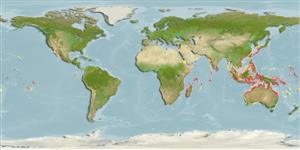>
Gobiiformes (Gobies) >
Gobiidae (Gobies) > Gobiinae
Etymology: Bathygobius: Greek, bathys = deep + Latin, gobius = gudgeon (Ref. 45335).
More on author: Fowler.
Environment: milieu / climate zone / depth range / distribution range
Ecología
marino asociado a arrecife. Tropical
Indo-West Pacific and Southeast Atlantic.
Tamaño / Peso / Age
Maturity: Lm ? range ? - ? cm
Max length : 5.0 cm TL macho / no sexado; (Ref. 2798)
Espinas dorsales (total): 7; Radios blandos dorsales (total): 9; Espinas anales 1; Radios blandos anales: 8. Males uniformly dark brown; fins dusky to black (Ref. 2798). Females light brown with crossbars on body; caudal base with dark bar; dorsal and caudal fins mottled, other fins clear (Ref. 2798); characterized further by having upper 5-6 pectoral rays partly free of membrane; rounded caudal fin; longitudinal scale series 28-32; predorsal scales 9-13, not reaching rear margin of preopercle; cheek, opercle, pectoral fin base and prepelvic area without scales; ctenoid body scales, becoming cycloid on head and anterior body (short distance anterior to first dorsal fin); depressed head, width greater than depth; depth of body 4.6-5.9 in SL (Ref. 90102).
Inhabits rock pools of intertidal zone, rocky shores and mangrove habitat (Ref. 90102).
Life cycle and mating behavior
Madurez | Reproducción | Puesta | Huevos | Fecundidad | Larva
Hoese, D.F., 1986. Gobiidae. p. 774-807. In M.M. Smith and P.C. Heemstra (eds.) Smiths' sea fishes. Springer-Verlag, Berlin. (Ref. 2798)
IUCN Red List Status (Ref. 130435)
Threat to humans
Harmless
Human uses
Más información
Nombres comunesSinónimosMetabolismoDespredadoresEcotoxicologíaReproducciónMadurezPuestaAgregación para la puestaFecundidadHuevosEgg development
ReferenciasAcuiculturaPerfil de acuiculturaRazasGenéticaElectrophoresesheritabilidadEnfermedadesProcesamientoNutrientsMass conversion
ColaboradoresImágenesStamps, Coins Misc.SonidosCiguateraVelocidadTipo de nataciónSuperficie branquialOtolitosCerebrosVisión
Herramientas
Special reports
Download XML
Fuentes de Internet
Estimates based on models
Preferred temperature (Ref.
123201): 24.2 - 29.3, mean 28.3 °C (based on 3126 cells).
Phylogenetic diversity index (Ref.
82804): PD
50 = 0.5000 [Uniqueness, from 0.5 = low to 2.0 = high].
Bayesian length-weight: a=0.00708 (0.00333 - 0.01504), b=3.09 (2.92 - 3.26), in cm total length, based on LWR estimates for this (Sub)family-body shape (Ref.
93245).
Nivel trófico (Ref.
69278): 3.3 ±0.5 se; based on size and trophs of closest relatives
Resiliencia (Ref.
120179): Alto, población duplicada en un tiempo mínimo inferior a 15 meses (Preliminary K or Fecundity.).
Fishing Vulnerability (Ref.
59153): Low vulnerability (10 of 100).
Nutrients (Ref.
124155): Calcium = 252 [112, 570] mg/100g; Iron = 1.07 [0.52, 2.17] mg/100g; Protein = 18 [16, 20] %; Omega3 = 0.0933 [, ] g/100g; Selenium = 21.7 [8.2, 54.6] μg/100g; VitaminA = 135 [34, 511] μg/100g; Zinc = 2.78 [1.68, 4.38] mg/100g (wet weight);
